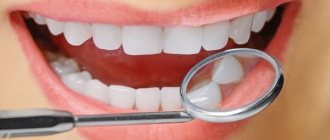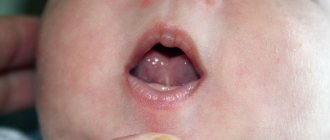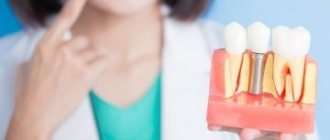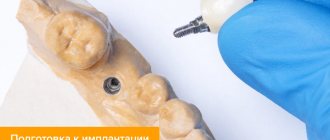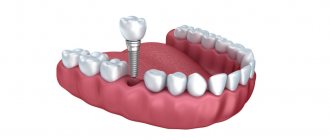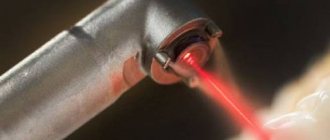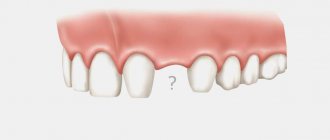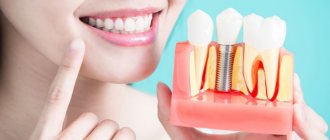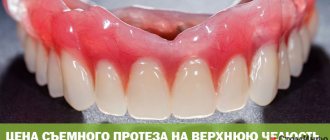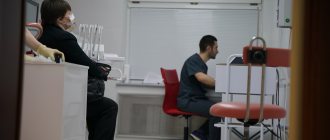Implantation
or
dental prosthetics
?
For an uninitiated person or, especially, one who has retained most of his teeth, both complex orthopedic terms sound the same - “insert teeth.” But both modern prosthetics and modern implantation are no longer just “inserting teeth
,” and certainly not
“a jaw in a cup
. This is a whole complex of procedures and measures, as a result of which new teeth made of artificial materials are practically no different from natural ones, do not cause discomfort and are in no way noticeable from the outside.
First of all, this concerns, of course, implantation. This type of replacing real teeth with artificial ones has significant advantages over standard prosthetics. If only because until recently all dentures were removable, which caused significant inconvenience to patients. Therefore, let's be honest: despite the fact that fixed prostheses are now being manufactured and successfully used, implants as a support provide much greater comfort and functionality.
However, both procedures have their pitfalls, which do not allow us to say with confidence that implantation or prosthetics is 100% better in absolutely all cases. How, when and under what circumstances implantation would be better, and when prosthetics would be better, we will now look at it.
What is better – implantation or prosthetics?
| Traditional dentures | Prosthetics on implants | |
| Aesthetics | Relatively high | Very high – prosthetic structures on implants are no different from the patient’s own teeth. |
| The need to pre-depulpate and grind teeth | Required - adjacent teeth act as supports for the prosthetic structure. | There is no need - the orthopedic system is fixed to the implant; combination (using living teeth and artificial roots simultaneously as a support) is not permissible. |
| Degree of denture fixation | In the presence of periodontal pathologies, the presence of even the slightest mobility of teeth, the prosthesis may not be securely fixed in the mouth. | Maximum – after complete osseointegration, the implant fully performs all the functions of a natural tooth root. |
| Load distribution on jaw tissue | The load falls exclusively on the living teeth in the row; bone atrophy develops in the area of the missing teeth; over time, a gap forms between the gum and the denture, in which bacterial plaque accumulates. | The chewing load is evenly distributed over the entire jaw, which eliminates the development of atrophic processes in soft and bone tissues. |
| Life time | Depending on the condition of the supporting teeth and the material of manufacture, the average service life is 5-10 years. Completely removable laminar dentures have to be replaced more often due to rapidly developing atrophy of the jaw tissue. | With proper care, the service life of a prosthesis installed on implants is 15 years or more. |
Operation
Medium complexity
There are contraindications
Doctor's qualifications
High
Doctor's advice - removable structures cannot compare in quality with an implant.
If you decide whether a removable denture or an implant is better, the choice is obvious. Removable structures cannot compare in quality to an implant. They need to be serviced every year, while an implant will last ten years without updating. Not all removable models are securely attached. In terms of comfort, removable structures are also inferior to implants. The latter do not bring discomfort to the patient, do not rub the gums and feel like natural teeth after just a couple of days.
Levin Dmitry Valerievich
Chief physician, Ph.D.
Dental implantation - features of the method
Installing an implant always involves surgery. This is an invasive procedure, the artificial root is fixed into the jaw by incision or puncture of the gum (depending on the implantation protocol used). The entire implantation process is divided into three main stages:
- Diagnostics and preparation.
- Implantation of an artificial root.
- Installation of an orthopedic system.
Implants can be installed in a one-step manner - into the tooth socket immediately after its removal, or using the classic two-stage method. Single-stage technologies include all-on-6, all-on-4, basal, and single-stage implantation protocols. These are gentle, minimally invasive techniques that allow you to restore full functionality to your teeth in just 1-3 days.
The classic two-stage method includes installation of an implant, which is often accompanied by osteoplasty, and the orthopedic structure is installed after complete engraftment of the artificial root.
Work examples
How often do you visit the dentist?
When is implantation the optimal and effective solution?
Implantation can solve any problems in the oral cavity. With the help of implants, you can restore teeth in any part of the jaw and in any quantity. Implantation will be especially interesting for patients with complete edentia. Today this is the most advanced way of recovery.
In this case, it is possible to perform an operation against the background of certain diseases that often cause tooth loss (periodontitis and periodontal disease, diabetes mellitus and others). Also, bone tissue atrophy in most cases does not become an obstacle. Implants can be installed simultaneously with the removal of destroyed units (in any required quantity), which reduces the number of surgical interventions and tissue trauma.
The optimal solution is implantation even if one tooth is missing - in this case, the implant will be installed strictly under it, and the others will not be injured. As, for example, it happens when installing a bridge structure, which literally disables two more supporting teeth located in the “neighborhood”.
The benefits of implantation include:
- an extensive list of indications: almost any clinical situation with tooth loss can be solved using this method. In addition, it is now possible to restore the ranks of those patients who have nothing left in the oral cavity with which to chew. Moreover, these solutions make it possible to get a new smile in just a few days. But until recently, apart from full removable devices, the patient had no other choice,
- with the development of technology, the method has become safe, low-traumatic, ensuring a high survival rate of implants at the level of 98–99%[2],
- there is no need to affect units adjacent to the defect in order to secure the structure. This extends their service life,
- high possibilities of prosthetics, the patient can choose from many methods,
- the ability of implants to stop bone atrophy and subsequently restore bone volume,
- reliable fixation of devices in the oral cavity, ensuring maximum comfort and quality of life,
- Easy care, just like taking care of your own teeth. The only thing is that it must be regular and of high quality - this is the key to the success of the implantation in the long term,
- virtually lifelong service life of implants that do not require replacement during life,
- the beauty and naturalness of a smile, the inconspicuousness of the attachment for others.
Read more about the benefits of implantation in the material “Pros and Advantages of Dental Restoration with Implants.”
Dental prosthetics - features of the method
Dental prosthetics is a non-invasive procedure for recreating missing teeth in a row using different, different techniques. The selection of the optimal technology is carried out by the doctor in accordance with the following criteria - the condition of the jaw bone, the type of defect, the presence of dental diseases, etc.
Dentures are divided into permanent and removable. Permanent prosthetics include crowns and bridges, which are widely known to patients. Removable structures have many varieties - full and partial, plate, clasp. The latter are one of the most reliable and comfortable, but at the same time complex and expensive designs.
Fixed and removable prosthetics includes the following stages:
- Preparatory
Elimination of current problems with teeth and gums, preliminary orthodontic treatment (bite correction, etc.), depulpation and grinding of supporting teeth.
- Manufacturing of dentures
In a dental laboratory, a prosthetic structure is made using individual impressions from the patient’s teeth.
- Installation
During fitting, the finished denture is adjusted to the required parameters, the shade and texture of the artificial teeth are adjusted, and the structure is fixed in the mouth.
Examples of work “Before” and “After”
ROOTT implantation with immediate loading and removable prosthetics (June 2015)
Case: periodontitis, destruction of remaining teeth, severe atrophy of bone tissue.
Implantation and prosthetics of one tooth
Case: loss of a front tooth due to an injury that occurred 3 years ago; the patient had not visited the clinic before.
Pros and cons of dentures
The arguments for classical prosthetics are:
- Affordable price for the procedure.
- The ability to close a gap of 1-2 missing teeth with an aesthetic bridge.
- Minimum contraindications.
- Quick and easy installation.
The disadvantages of the method include:
- The need to grind abutment teeth.
- Fragility of prosthetic systems.
- Rapid recession of the jaw bone under the denture.
- Partial restoration of chewing function.
- The need to reinstall the structure every 3-7 years (depending on the type of prosthesis, material and manufacturing technology)
Traditional dentures differ from dental implantation in the technique of installing the prosthetic structure; all other differences in methods also follow from this.
What is a dental implant?
This is a device fixed into the bone tissue of the jaw and replaces a fallen or initially missing tooth. Dental implants support crowns, bridges of various lengths, removable and fixed dentures.
Several types of implants are used in dentistry, but the most widespread are root-shaped implants. These are structures consisting of a metal rod implanted into the jaw tissue and an abutment - an artificial tooth that is ground into a crown. If necessary, a gum former is installed on the implant shaft - a special metal screw with a cap. It is attached to the implant before installing the abutment and forms the gum relief to achieve an aesthetic result.
Root-shaped implants are cylindrical and screw with thread. The latter are more common, since due to the thread, the implant fuses more firmly with the jaw tissue.
Indications for dental prosthetics
Indications for traditional dental prosthetics and implantation are the same:
- Single or multiple dentition defects included.
- Absence of outer teeth in a row.
- Complete edentia of one or both jaws.
Not so long ago, there was a wide range of absolute contraindications to implantation. Improvements in implantation protocols today have reduced this list to just a few items. Most contraindications are eliminated at the preparatory stage for implantation.
Expert opinion
Emir Romanovich Omerelli
Maxillofacial surgeon, implantologist
Experience: more than 13 years
The main rule when restoring completely or partially lost teeth is the correct reconstruction of the dentition from a functional and aesthetic point of view. From an aesthetics point of view, the prosthesis must fit harmoniously into the dentition, look natural, have an anatomically correct shape and ensure proper closure of the dentition. The functional side of the issue determines the ability of the orthopedic design to fully participate in the process of chewing and speech, as well as correctly distribute chewing loads. Permanent prosthetics on implants fully meets all requirements, allowing you to restore the full functionality of the dental system even with complete edentia.
What is cheaper – implantation or dental prosthetics?
| Restoration of 1 tooth | Restoration of 3 teeth |
|
|
The final price of a denture depends on the materials used and manufacturing technologies, the number of dental units that require replacement with artificial ones and some other criteria.
The main advantage of dental implantation is that the artificial root is implanted for life, and the crown or prosthesis installed on it will last about 15-20 years or more. Orthopedic structures that rely on adjacent teeth need to be reinstalled every 5-7, maximum 10 years. Complete dentures are replaced every 3-4 years due to the rapid recession of the jawbone.
Implantation - arguments for!
- Does not require grinding of adjacent healthy teeth.
- Completely restores chewing function.
- Impeccable aesthetics - artificial teeth completely imitate natural ones.
- Allows you to fill the gap of any number of teeth.
- No changes in the gingival contour - even after a long time, the gums do not recede and do not expose the area where the crowns connect to the abutment.
- The structure of the titanium pin activates the growth of bone tissue in the area of implantation and stimulates tissue metabolism processes.
- The prosthetic structure placed on the abutment can be easily replaced if necessary.
- The ability to choose the ideal implantation technology for a specific patient.
- The ability to restore the dentition without additional jawbone building.
- Reliability, long service life (25 years or more).
- Absence of destructive changes in speech and taste.
Dentist's opinion
According to experts, implantation is a more reliable, aesthetic and physiological method of dental restoration. Based on the price you have to pay immediately for the procedure, installing an implant is more expensive. But looking ahead 8-10 years, we can confidently say that an implant with a crown is cheaper than a classic bridge. The mathematics is simple - with each subsequent reinstallation of a bridge, you will have to restore not 1 lost tooth, but 2 or even 3, so what kind of savings can we talk about?
Important: it is not recommended to put a bridge on your teeth if you are missing 3 teeth in a row, because... such a long bridge will balance over time due to bone atrophy.
Questions and answers
Basal implantation with dentures (1 jaw)!!!! How can I make an appointment with you for a consultation?
Basal implantation with dentures (1 jaw)!!!! How can I make an appointment with you for a consultation?
Hello! You can sign up for a free consultation on dental implantation by calling + or 8 800 333-53-41 (free for regions). Our specialists will select a convenient time for your consultation and answer all additional questions about basal dental implantation. Sincerely, Patient Support Center SIMPLADENT++ 78
As a result of illness (fluorosis), he lost a large number of teeth. Orthopedists in our city offer removable dentures. Tell me, what prosthetic options are possible in my case?
As a result of illness (fluorosis), he lost a large number of teeth. Orthopedists in our city offer removable dentures. Tell me, what prosthetic options are possible in my case?
Hello! In your case, in order to recommend possible options for dental restoration, it is necessary to first analyze the image and also conduct an examination of the oral cavity. It is necessary to understand why you were not offered to have dental bridges or dentures on implants, why the orthopedist suggested that you install removable bridges. If you have such an opportunity, we suggest that you attend a free consultation at one of our clinics so that our doctors can conduct a direct examination, since a remote consultation still does not give the full picture. You can make an appointment with our specialists by calling the numbers listed below. Sincerely, Patient Support Center SIMPLADENT++ 78-800-333-53-41
Other questions
Other jobs
Where to go for treatment
If you have lost one or more teeth, you are well aware of the unpleasant consequences of this loss. For many people, missing teeth is a very unpleasant experience, associated with a deterioration in appearance, the discomfort of loose dentures, pain, difficulty eating and a less active lifestyle. By choosing implants, you can solve all these problems.
The main advantages of implants:
- Implants look and function like natural teeth. Due to their design, they are firmly connected to the bone.
- Removable dentures are not comfortable, causing a lisp and slurred speech. Implants allow you to speak freely without worrying about dentures.
- Thanks to their permanent connection to the bone (osseointegration), implants eliminate the discomfort of removable dentures.
- Implants improve your smile and boost your self-confidence.
- Implants do not require grinding down other healthy teeth like denture bridges. This allows you to maintain a better level of oral health. Individual implants provide better access to interdental spaces, facilitating oral hygiene.
- The implants are made of titanium and are therefore very durable. With proper care, implants can last a lifetime.
Experts from reputable dental centers in the capital will help you decide what to choose in your specific clinical case – prosthetics or implants.
| Clinic address | Clinic | Price |
| Dentistry ROOTT |
|
| Moscow, Kolpachny lane, 6, building 4. | Dentistry Sandora |
|
| Dentistry Prosmail.RU |
|
| Moscow, metro station "Butyrskaya", Rustaveli Street, building 15 | Dental Clinic Dention |
|
| Moscow, metro station Barrikadnaya st. Zoologicheskaya, 2, under. 9 | Dentistry DENTAL DREAM |
|
| Moscow, Zvenigorodskoye sh., 7 | Dentistry Implant Expert | Nobel implantation, USA, from 50,000 rubles, Astra Tech implantation, Sweden from 47,200 rubles, OSSTEM Korea - 27,000 rubles |
| Moscow, Bolshoi Sergievsky lane, 5 | Dentistry Viva-dent | Dental implantation depending on complexity: 31,000 - 41,000 rubles per 1 tooth |
| Moscow, st. Molodtsova, 2a | Family discount dentistry | Implantation is carried out using various systems - Astra Tech (Sweden), Ankylos Densply (Germany), Dentium (Korea), the price for 1 restored tooth is from 30,000 rubles. |
| Moscow, Paveletskaya sq., 1 | Dental Clinic Denta VIP | Implantation of the IMPLA system (Germany), OSSTEM (Korea) - from 36,000 rubles. Astra Tech (Sweden) – from 45,000 rubles. |
| Moscow, st. Lyublinskaya, 161 | Dentistry PRESIDENT |
|
When should you choose prosthetics? Depends on contraindications for implantation
It should be remembered that implantation is possible only if there are no contraindications for it, and, alas, there are many of them. These include a number of relative and absolute ones. If in the first case the situation is surmountable and can be solved with the help of additional treatment and preparation for surgery, then in the second the restrictions are built mainly around the necessary surgical intervention and its consequences.
Therefore, the following situations are contraindications for implantation - and then classical prosthetics will really be suitable:
- serious diseases of the immune system: lupus erythematosus, Sjögren's syndrome, Behçet's disease,
- uncompensated (unstable) diabetes mellitus with constantly elevated glucose levels,
- pathologies associated with blood clotting disorders, blood diseases,
- problems with the nervous and cardiovascular systems,
- tuberculosis infection,
- oncological tumors of any location (not in remission),
- ban on anesthesia and the use of anesthesia,
- mental disorders,
- arthritis, rheumatic and rheumatoid,
- severe atrophy of bone tissue, when its height and width do not allow the installation of even the most modern implants.
That is, all situations when it is better not to undergo surgical intervention.
For more information about contraindications and ways to overcome them, if possible, read the article on the website “When you can and cannot install dental implants - a complete list of tolerances and prohibitions.”
If you have serious health problems, you should not insist on implantation, because this can come back to haunt you both during the operation to install implants and after it. Possible complications include tissue inflammation, implant rejection, exacerbation of chronic diseases and deterioration of the general condition of the body. In these cases, the installation of implants is prohibited and it is better to opt for alternative replacement methods - removable or conditionally removable prosthetics.
With relative contraindications, in addition to the fact that additional treatment will require significant financial costs, it greatly extends the process of dental restoration over time. To solve the issue of bone tissue atrophy, today there are implantation protocols that make it possible to completely abandon bone augmentation.
What is the advantage of implants over dental prosthetics?
The bone tissue around the tooth root is maintained by a natural regeneration process. When a tooth is removed, atrophy occurs where the tooth once was, changing the shape of the upper or lower jaw. A dental implant placed in place of a lost tooth stimulates bone development and growth and prevents the loss of valuable alveolar bone structure.
When implants are fully osseointegrated with the bone, they function just like natural teeth. You can eat whatever you want and speak clearly. For denture wearers, eating an apple can be a challenge due to loose dentures or gum pain caused by extreme pressure. Gum irritation and inflammation are a common problem in people with dentures. The denture can be supported on implants, which will significantly improve its stability and functionality, allowing the patient to feel much more comfortable.
Unlike bridges and dentures, which require special care, caring for dental implants requires only regular brushing, flossing, and standard biannual dental visits, just like with natural teeth.
To get a consultation
What happens if you don’t restore a lost tooth?
Losing one tooth does not seem to be a significant problem. But this is only at first glance. In fact, the loss of even one unit entails a whole chain of negative changes, not only in functional terms. This also affects the aesthetics of the face and the health of the entire dental apparatus.
First of all, the teeth adjacent to the defect begin to shift. They strive to fill the empty space, shift towards it, the closure of the teeth is disrupted, and the entire dentition is bent. In addition, the antagonist tooth suffers. He loses his support and begins to move towards the same empty space. Bone resorption begins - bone tissue decreases due to lack of load during chewing.
As a result of all these changes, the temporomandibular joint suffers, jaw clicks, headaches, tension in the muscles of the face and tongue may appear. If a front tooth is missing, aesthetics also suffer. Diction changes, emotional discomfort appears.
Advantages and disadvantages of implants
If no contraindications are identified, then dentists advocate implantation. The only people against implants are doctors who do not have sufficient qualifications to perform such operations and recommend the installation of a removable prosthesis in their own interests, and not in the interests of the patient.
After all, the undeniable advantages of implantation are the restoration of the functions of a lost tooth, the prevention of deformation of bone tissue and facial features, and the absence of the need to grind adjacent teeth.
For many, the rather high price can be an obstacle to installing implants. But implantation pays off in the future, because as stated above, I install implants for almost my entire life.
What is more reliable according to doctors?
Mikhail, dentist-implantologist
Implantation is a fairly effective way to correct edentia. Classic prosthetics is gradually losing its position. Conscientious specialists try not to resort to this method. They solve the problem with the help of implantology, mini-implantology. However, there are some disadvantages that must be taken into account by the doctor. If the risks exceed acceptable ones, then it is necessary to get out of the situation in another way.
Oleg, implant surgeon, orthopedist
The installation of a bridge is often accompanied by complications; you need to be prepared for this. Unfortunately, the doctor’s experience does not solve anything here. Implantation is another matter. Here, on the contrary, the qualifications of a specialist are the main driving factor. It is important to conduct a full examination, properly prepare the oral cavity, and identify contraindications.
Survival and service life of implants
The healing time of implants is: on the upper jaw - from 6 months, on the lower jaw - from 3 months. Much here depends on the age of the patient, the quality of his bone tissue and the experience of the doctor installing the implants. But, if the implant is successfully implanted, it is almost impossible to remove it from the jaw.
A well-established implant will serve you for at least thirty years. If you follow your doctor's recommendations, the implant will last a lifetime. This refers to the part of the implant that is placed into the gum, the plate and abutment. The crown placed on the implant will have to be replaced, but it will last 10-15, or even 20 years.
